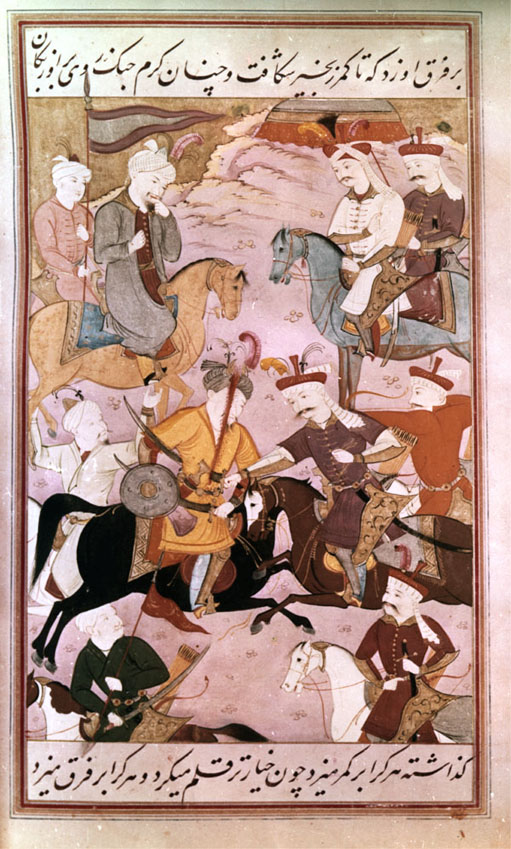Manuscripts
tāriḵ-e ʿālām-ārā-ye šāh esmāʿil
In 916/1510 Shāh Esmāʿil decided that there could be no peace with Šāhibeg Ḵān and the Uzbegs. He mobilized his forces and marched on Khorasan, where the Uzbeg governors abandoned their seats and fell back to Herat. When Esmāʿil’s forces reached Mashad, Šāhibeg decided he had not sufficient strength to withstand the Safavid forces and withdrew to Marv, leaving his nephew Jān Vafā Mirzā to defend Herat. But he, too, soon abandoned his post and fled to Marv with Esmāʿil in pursuit. When the Safavid van neared the walls of the citadel, Jān Vafā Mirzā came out with a strong force to engage them. Hard fighting took place and Dāna Moḥammad Solṭān, the commander of the Safavid advanced guard, was killed by Juli Bahādor, commonly known as Juli the Uzbeg. Among the qezelbāš was Dāna Moḥammad’s son, ʿAḵi Soltān by name, who, upon seeing his father slain immediately rode forward to challenge the Uzbeg. His challenge was successful and Juli was killed in the confrontation. The Safavids went on to route the force led by Jān Vafā Mirzā which retreated in disorder to the confines of the city walls.
The two combatants and their horses boldly stretch across the bottom of the painting. ʿAḵi Solṭān, in purple with a red and white tāj and red kolāh, charges from the right. Leaning forward in the saddle of his chestnut horse, he thrusts, his right arm extended with sword in hand. Juli, in yellow with a gray turban, advances from the left on a black mount. He has obviously been caught off-guard by the swiftness and ferocity of his adversary’s attack, for he is still holding his sword and shield at his waist. But ʿAḵi Solṭān’s sword has already found it’s mark, and Juli, in the words of the text, has been cut up like a fresh cucumber. Behind ʿAḵi Solṭān is another Safavid, in vermillion, his bow drawn taught aiming at an Uzbeg who rides out of the picture, his arms raised in despair, on the opposite side of the composition. Another qezelbāš in maroon, in the lower right, calmly sits on a white horse observing the battle. He is balanced

compositionally by an Uzbeg in green in the left corner, who calmly rides out of the picture carrying a standard while casting a glance over his shoulder. The upper ground of the painting is again near-symmetrically disposed. Shah Esmāʿil sits in the upper right on a blue-gray horse observing the event below. An aide riding behind him holds the vermillion, gray, and gold ceremonial umbrella of kingship over his head. In the upper left, balancing the shah group, is an Uzbeg dignitary and a standard bearer. This dignitary, who may be identified as Jān Vafā Mirzā, wears a white turban and a long gray robe over a maroon dress, and gestures astonishment with his finger to his lip. The backdrop is simply handled: a pale mauve hillside that rises to a craggy rock formation at the top, beyond which is a gold sky. Some spatial problems are readily apparent in the painting. The head of the figure in the lower left corner, who is supposed to be in the immediate foreground, is overlapped by the rear legs of Juli Bahādor’s horse. The Uzbeg behind Juli, according to the pictorial conception used, would be higher in the composition, but to the contrary is portrayed substantially lower. And thirdly, the umbrella of state that is held aloft is supposed to be over Esmāʿil’s head, yet the feathers on his hat overlap it.
Painting: 19.5 x 13.0 cm. One line of text above and below the painting. Some light smearing in the lower left corner, but no other signs of damage or retouching. No marginal inscription.
Painting references:
Mahboubian_1972, #923 folio 199v (not ill.).
Text X-references:
See Muntaẓer-Ṣāḥeb_1970, p.355 for this event in the History of Shah Esmāʿil.
See Savory, SA_1979, pp.60-61 for this event in the History of Shah ʿĀbbās.
Robert Eng
Last Updated: December 13, 2010
Originally published: April 4, 2002